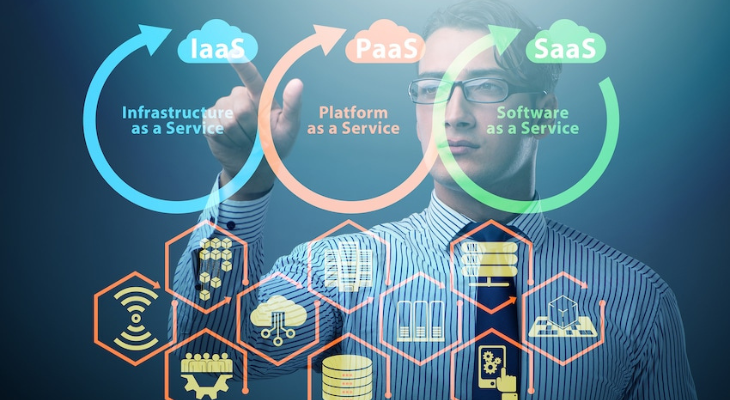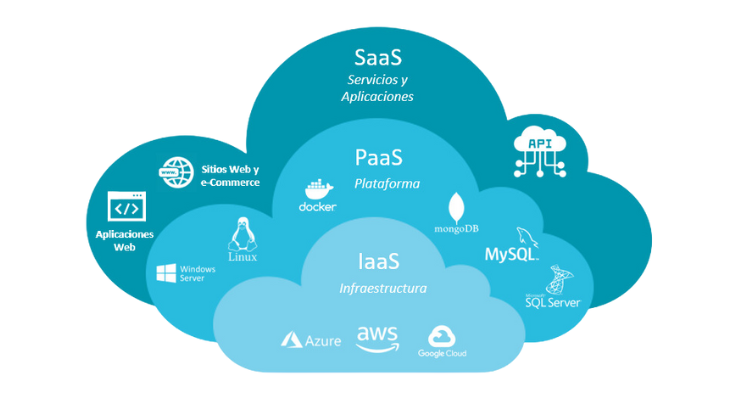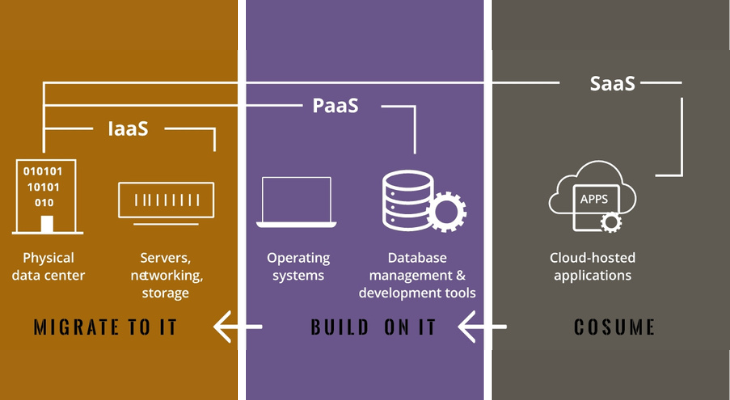SaaS, PaaS, and IaaS: Understanding and Examples

Cloud computing has completely changed how people and businesses access and manage their IT resources in the modern digital world. There are many different types of cloud services, but there are three main models that have different benefits and are used for diverse purposes: Infrastructure as a Service (IaaS), Platform as a Service (PaaS), and Software as a Service (SaaS). In order to assist you in selecting the cloud service model that best meets your unique requirements, we will examine the main distinctions between these three cloud service models in this post.
Table of Contents
ToggleUnderstanding SaaS, PaaS, and IaaS
- Infrastructure as a Service (IAAS): IAAS is a method of providing on-demand computer infrastructure services. It is among the three basic models of cloud services. Through a fully outsourced, on-demand service model, the user purchases servers, software, data center space, or network equipment and rents those resources. It distributes the resources as a service and permits dynamic scaling. Usually, numerous users can share a single piece of hardware.
- Platform As A Service (PAAS): This cloud delivery model consists of services that are overseen by an outside party and is used for apps. It offers elastic application scaling, enabling developers to create online services and applications with public, private, and hybrid deployment options.
- Software As A Service (SaaS): This model of software is deployed as a hosting service and accessed over the internet or software delivery model, in which software and its related data are hosted centrally and accessed using their client, typically an online browser. It enables users to run pre-existing online applications.
key differences between (IaaS), (PaaS), and (SaaS)

Aspect | IaaS | PaaS | SaaS |
Definition | Provides virtualized computing resources (e.g., servers, storage, networking) on a pay-as-you-go basis. | Offers a platform with tools and services for application development, deployment, and management. | distributes software via the internet, usually with a subscription model |
User Control | Offers a high degree of control over infrastructure, allowing users to manage virtual machines and networking. | Offers less control over the underlying infrastructure as the focus is on application development and deployment. | Users have no control over the underlying infrastructure; they only interact with the software application. |
Responsibility | Users are responsible for managing and maintaining the operating system, middleware, and applications. | The platform provider manages the underlying infrastructure, while users focus on application development and data. | The service provider handles everything, including infrastructure, application maintenance, updates, and support. |
Use Cases | Best for organizations that need control over their infrastructure and want to run custom software and applications. | Ideal for developers and teams focused on building, deploying, and scaling applications without worrying about infrastructure management. | Suited for end-users or businesses looking for ready-to-use software solutions without the need for development or infrastructure management. |
Examples | Google Cloud Platform (GCP), Microsoft Azure, and Amazon Web Services (AWS). | Microsoft Azure App Service, Heroku, and Google App Engine. | Salesforce, Google Workspace, Microsoft 365. |
Major differences among cloud IaaS, PaaS, SaaS, and CaaS
When it comes to cloud computing, knowing the distinctions between IaaS, PaaS, SaaS, and CaaS boils down to responsibility and control levels. Depending on the model you select, the service provider will handle different components of the computing stack, but all models provide an option to managing your own on-premises data center.
The comparison of who is in charge of managing what for IaaS, PaaS, SaaS, and CaaS is depicted in the diagram below:
It could be helpful to conceive of cloud computing in terms of housing in order to better understand it and the various types available:
- On-premises: Everything is done by you if you choose to construct your own home from the ground up. You’ll have to find the supplies and equipment, assemble everything, and make many trips to the store for supplies. This is comparable to operating an application on-premises, where you are in complete control of the hardware, software, and scalability.
- Infrastructure as a service: You may want to think about contracting out the task to a contractor if you are too busy. You give them the layout and number of rooms you desire, and they follow your directions to construct your dream home. The way IaaS functions for your apps is similar. The hardware on which your program runs is rented, but you are in charge of scaling, managing the OS, runtime, and all of the data. Consider a computer engine.
- Containers as a service: Renting is an option if owning a home is just too much labor because of the upkeep involved. You furnish the room with your own furniture and personalize it; the necessary utilities are provided. You can bring a containerized application with you and maintain control over runtime and scale without worrying about the underlying operating system thanks to containers. Google Kubernetes Engine (GKE) is one example.
- Platform as a service: You can rent a furnished home if you don’t want to bother with furnishing your living area. Although PaaS enables you to bring your own code and deploy it, the cloud provider handles server maintenance and scaling. Examples are Cloud Run and App Engine.
- Serve as a service: You can hire a desk at a cowering space if all you need is a tiny, dedicated office away from your home. In a similar vein, FaaS enables you to create and implement a function—a brief segment of code—that carries out a particular activity. As a function runs, the cloud provider provides scale as needed. For instance, cloud functions
- Software as a service: Let’s say you buy or rent a finished home, and you have maintenance costs like cleaning and yard maintenance. SaaS works similarly in that you pay to utilize a whole application for a particular purpose, and the cloud provider manages, maintains, and secures it; however, you are in charge of managing your own data. Google Workspace, for instance
Cost Comparison of SaaS, PaaS, and IaaS

Cost is a significant factor when deciding between Software as a Service (SaaS), Platform as a Service (PaaS), and Infrastructure as a Service (IaaS). Let’s delve into the cost considerations for each of these cloud service models in more detail:
SaaS (Software as a Service)
- Subscription-Based Pricing: SaaS is renowned for its subscription-based pricing model. Users pay a recurring fee, typically on a monthly or yearly basis, which can make budgeting more predictable.
- Low Upfront Costs: Since SaaS applications are hosted by providers, there is no need for businesses to invest heavily in infrastructure, software development, or IT staff. This can significantly reduce upfront costs.
- Reduced Maintenance Costs: SaaS providers handle software maintenance, updates, and support, which can lead to cost savings. Users are relieved from the responsibility of maintaining the software themselves.
- Scalability Costs: As your organization’s needs grow, the costs of scaling up SaaS services can increase. Providers often charge based on the number of users or additional features, so it’s essential to consider how scaling might affect your budget.
PaaS (Platform as a Service)
- Development and Runtime Costs: PaaS includes expenses related to both development and runtime. While development costs can be relatively low due to the availability of development tools, the runtime costs can increase as your applications use more resources.
- Resource Efficiency: PaaS can lead to cost efficiency in development as it streamlines the development process. However, it’s crucial to optimize your application’s resource usage to control runtime costs effectively.
- Potential Vendor Lock-In Costs: Vendor lock-in can be a cost concern with PaaS. If you decide to switch providers or platforms, migration costs and training for new tools can add to the overall cost.
IaaS (Infrastructure as a Service)
- Scaling Cost Factors: IaaS costs are more dynamic, as users pay for the resources they consume. While this can be cost-effective when resources are used efficiently, improper scaling can lead to unexpected expenses.
- Infrastructure Management Costs: IaaS grants greater control but comes with the responsibility of managing the infrastructure. This may require additional staff or the use of managed services, impacting costs.
- Storage Costs: IaaS often involves storage costs, including fees for data transfer and data storage. It’s essential to monitor and manage your storage to avoid unnecessary expenses.
- Data Transfer Fees: Data transfer between IaaS resources or from the cloud to external sources can incur additional costs. Keeping track of data transfer volumes is crucial for cost control.
Scalability and Resource Management
Aspect | SaaS | PaaS | IaaS |
Scalability | – SaaS scalability may be limited by the service provider’s infrastructure and design. Scaling is often managed by the provider. | PaaS offers more flexible application scalability.Developers can scale application resources with ease, using the platform’s tools.- Well-suited for dynamic applications that experience varying workloads. | – Fine-grained control over scalability is offered by IaaS.. Users can scale virtual machines, storage, and networking components based on their needs.- Highly adaptable for unpredictable workloads. |
Resource Management | Resource management in SaaS is limited as it’s primarily managed by the service provider. | PaaS focuses on application resource management.- Users have control over application-specific resources, such as databases and servers.- Well-suited for application developers. | IaaS offers comprehensive resource management.- Users have control over virtual machines, storage, and networking.Requires more hands-on infrastructure management. |
Conclusion
In conclusion, your specific needs and goals will determine which of SaaS, PaaS, and IaaS is best for you. You can make an informed choice and take advantage of cloud computing’s potential for success by being aware of the main distinctions and taking into account the elements that are most important to your company.
FAQs about SaaS, PaaS, and IaaS
What distinguishes SaaS, PaaS, and IaaS from one another?
Platforms for development are offered by PaaS, virtualized IT resources are provided by IaaS, and cloud-based applications are provided by SaaS.
SaaS, PaaS, or IaaS, which is more economical?
Cost-effectiveness is based on your own requirements. IaaS provides scalable, pay-as-you-go pricing, PaaS mixes development and runtime charges, while SaaS is subscription-based.
When utilizing SaaS, PaaS, or IaaS, how can I guarantee data security?
While PaaS concentrates on application security, IaaS enables you to put up personalized security protocols, and SaaS providers carry out data security measures.
Can I use SaaS, PaaS, and IaaS to customize applications?
PaaS provides more freedom in app creation compared to SaaS, which has restricted customization choices. More control over customizing the infrastructure is offered byIaaS.
Which cloud service model’s typical use cases are there?
PaaS is best for developing apps, IaaS is appropriate for scalable infrastructure solutions, and SaaS is utilized for business applications like email and CRM.
What is the best way to select the appropriate cloud service model for my project?
Take into account your unique demands, spending limit, security specifications, scalability, and use cases. Making an informed choice might also be aided by expert consultation.





One Comment